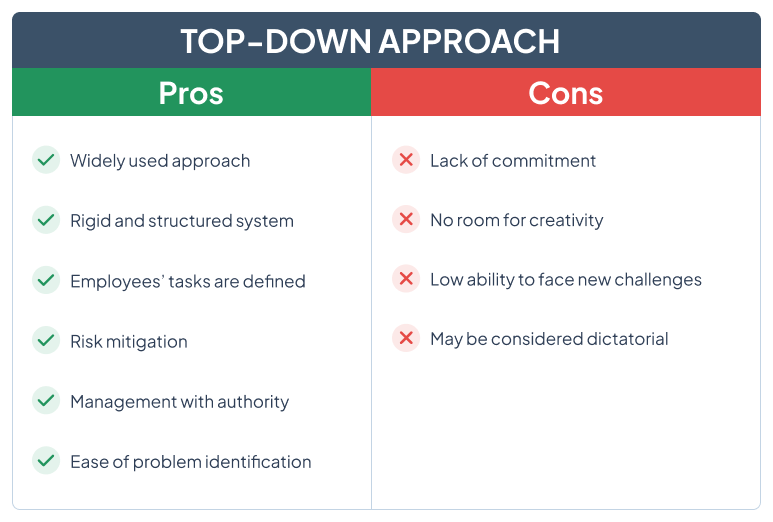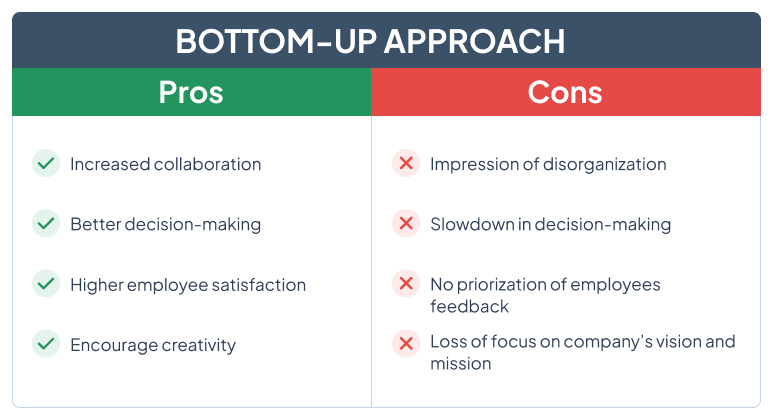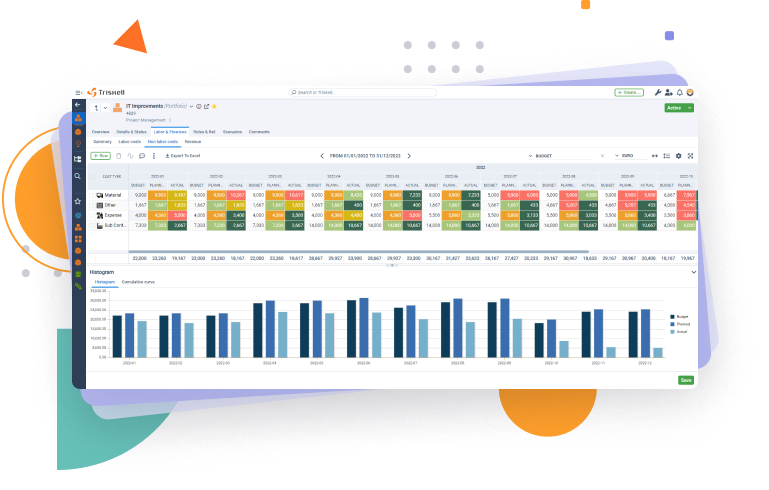
10 types of Project Management Offices (PMO): structure, purpose and how to choose the right one
Learn about different PMO types, their governance levels, and which one is the best fit for your company’s project management needs.

Top-Down vs Bottom-up: What´s the best approach? Business strategy, despite being the buzzword of many CEOs and executives, remains a major headache for most medium and large companies. They all have big plans, detailed with OKRs, KPIs and SMART objectives that illustrate the company’s mission and vision and where it wants to go.
All corporations invest an enormous amount of time in detailing their strategy. But how much time do they spend on designing the right way to execute that strategy? Many executives still rely on top-down management approaches to translate that strategy to the different organizational levels. But, is this the only right solution? What about the department heads and staff in charge of the execution of this strategy? Shouldn’t they also have a say?
Top-Down vs Bottom-up approach. It is the great dilemma for many companies: choosing the right approach to planning and managing business strategy execution. In this post, we explain their characteristics, their advantages and disadvantages, and the different formulas for combining them in the same corporation.
TABLE OF CONTENTS
Whether to opt for a top-down or bottom-up management approach (or a combination of both) depends on many factors. The industry, size, organizational culture and management model of the company influence the choice of one approach or another.

STRATEGIC PORTFOLIO MANAGEMENT
Align Top-Down Vision with Bottom-Up execution
Learn more about Triskell’s Strategic Portoflio Management solution.
Top-Down management approach is more applicable in organizations where decision-making occurs at the highest level and is then communicated to the rest of the company’s areas and departments.
However, in a bottom-up management approach, the organization’s leaders and executives delegate the decision-making process to employees so that all members of the organization maximize, in one way or another, the value they bring to the organization.
Therefore, when speaking of top-down and bottom-up approaches, they should not necessarily be considered antagonistic, but can be applied in many different ways and can even coexist in the same organization.
Top-Down and Bottom-up approaches should not necessarily be considered antagonistic
So, to find out which management approach best suits your needs, we will explain below the main characteristics, benefits and challenges of the Top-Down and Bottom-up approaches.
The Top-Down management approach is predominant in large corporations, especially those in industries that require strict control of their value chains to ensure the quality and safety of their products and services.
Here, strategic decisions are taken at the highest level. The objectives are then communicated to the different areas and departments of the organization, which in turn must inform the organization’s managers of the action plans they will carry out to contribute to the achievement of the goals set by the company’s Senior Management.
Also called “command and control” system, this is a highly hierarchical management approach with no room for improvisation. This, depending on the context, has its drawbacks but also its advantages, as explained below.
WHITE PAPER
Strategic Planning: From scrap head to moon shot
The advantages of the Top-Down management approach are especially visible in those organizations that are composed of several teams and function together as a larger organizational hierarchy. Strategic objectives are established at the highest level of the organization and then communicated in a hierarchical manner to all members of the organization.
These are the advantages of the Top-Down management approach:
All of us, throughout our professional careers, have worked in companies with this management approach. Therefore, the learning curve for managers and team leaders is minimal, except for the necessary training to familiarize them with the organization’s mission and vision or to incorporate certain management techniques with which they may not be familiar.
For complex organizations that require clear and well-structured processes for their correct operation, the Top-Down management approach will help bring order to the chaos. The same will happen in organizations composed of several departments that in turn are also composed of several smaller teams.
SUBSCRIBE TO OUR NEWSLETTER
Get stories like this in your inbox
Top-Down management approaches, if well implemented, will positively impact the organization of the tasks of each of the teams. All employees will have well-defined responsibilities within the organization, which will help them to focus only on doing their job properly.
Related to the previous point, a Top-Down management approach eliminates the risk of employees with a more fractious or anarchic profile assuming strategic responsibilities that, due to their role and functions, do not correspond to them.
The decision-making in organizations that adopt a Top-Down management approach is highly centralized in their highest authority, who decides both the strategic planning and the way in which this strategy will be executed.
By having all teams with well-defined tasks, it is easier to identify the root cause of problems and bottlenecks in the organization’s business processes. All employees will have well-defined responsibilities within the organization, which will help them to focus only on doing their job properly.
Close the gap between strategy and execution
Request a demo today and see how Triskell can help you define clear strategic objectives, prioritize initiatives, and cascade your vision across the organization.
However, this Top-Down management approach may not be to everyone’s liking, especially in a new era where new, more agile ways of leadership are becoming trendy, which prefer to empower teams and individuals and move away from the classic “command and control” view.
These are the disadvantages of the Top-Down approach:
This management approach is very likely to cause employees to be unable to see the value their work brings to the organization. In the long term, many employees may become disconnected from the mission and purpose of the company they work for.
Many employees can easily disconnect from the company’s mission and vision
Since the teams have very well-defined responsibilities, they will not be proactive in solving management problems or issues that do not directly concern them. Neither will they propose solutions that deviate from internally established standards and processes.
Organizations with a top-down management approach are more rigid when it comes to reacting to possible changes in strategy or solving complex management and governance challenges internally.
The Top-Down management approach will displease those employees who want to enjoy a certain degree of autonomy or who are excluded from decision-making processes. It is a management method that, if poorly executed and without proper communication, can lead to a high turnover rate in companies.

The bottom-up management approach involves the democratization of an organization’s decision-making. In contrast to the Top-Down approach, top management gives way to the role of the “leader” and empowers employees at all levels of the organization to have a say in strategy.
The ultimate goal of the Bottom-up approach is to maximize the value employees provide
It is a management style more typical of agile organizations in which the leaders of the different teams have great autonomy both to develop their work and to determine their own priorities and outcomes of the work to be delivered. The ultimate goal of this very democratic management approach is to maximize the value that each employee brings to the organization.
The advantages of the Bottom-up management approach are best seen in highly changing and dynamic work environments, such as start-ups or New Product Development teams, where agile and multidisciplinary departments are required to respond efficiently to the management and governance challenges they face.
These are some of the advantages of the bottom-up management approach:
This is the main hallmark of bottom-up management environments: all employees actively collaborate in delivering value. Hence, peer-to-peer discussion is encouraged among all employees in the organization to implement new ideas or solve problems.

PROJECT PORTFOLIO MANAGEMENT
Bridge the gap between top-down and bottom-up approaches
Learn more about Triskell’s PPM solutions.
While in Top-Down management methods the resolution of the most complex management and governance problems is left in the hands of Top Management, the opposite occurs here. By ‘democratizing’ decision-making, a greater number of people deliberate and participate in the resolution of these challenges. And, in most cases, this means a more efficient solution to these problems.
Employees who work with this approach can see how their opinions are taken into account and the value their work brings to the achievement of the organization’s mission and vision. This improves team morale and, therefore, also the likelihood of a lower staff turnover rate.
Opportunities to provide feedback and suggestions for improvement are the bread and butter of the collaborative environments fostered in bottom-up management environments. Whether in One-to-One meetings with team leaders, brainstorming sessions, or in the day-to-day dynamics of the Agile teams in the organization, employees are not restricted in coming up with new ideas.
WHITE PAPER
Are you cascading your strategy, or Fragmenting it?
However, bottom-up management brings with it challenges and pitfalls that can arise even in work environments that are most suitable for this type of approach. Decentralization of management and decision-making, both for strategic planning and execution, will not always work well if it is not done correctly.
These are the main disadvantages of the bottom-up management approach:
As decision-making is decentralized, there may be a certain feeling of insecurity and lack of control. In the case of certain decisions that may be relevant to the company, the fact that a bottom-up management approach is in place sometimes makes it unclear whether or not the approval of a manager is necessary.
When it comes to making certain decisions, and given that there are so many stakeholders with a voice and a vote, it can be difficult to get everyone on the same page. And, as a result, this can slow down the decision-making processes.
In bottom-up management models, decision-making processes can be slowed down
Not all feedback given by employees will have the same relevance at the strategic level. It is important that, if you opt for a bottom-up management approach, you have artifacts to channel those insights provided by employees to determine which are really valuable and which are not.
A poorly executed bottom-up management approach can lead an organization to undertake projects and initiatives that are far removed from its strategic objectives.

Top-Down or Bottom-Up? There is no written manifesto detailing the formula for choosing one management approach or the other. The success factors of one management model or another depend on multiple factors, among which the following can be listed:
Before deciding on one management model or another, you should conduct an internal analysis of your organization. By understanding your mission, vision, strengths and weaknesses, you will be able to choose the management approach that best suits your needs.
In many sectors, this management approach is the most widespread, mainly due to the quality controls to which their production systems are subject. Industries such as Retail, Healthcare, Industry or Engineering often use this management approach.
There are others, such as the Finance, Banking or Insurance sectors, which have so many regulations and policies behind them in so many areas (Regulations at the international level, Cybersecurity, Compliance, etc), where this Top-Down approach is necessary to minimize any margin of error.
On the other hand, a bottom-up management approach can hardly be applied in its entirety in large corporations. The more voices that have a say, the more complex the decision-making process. Therefore, this management approach is not recommended for large corporations except for some IT and Development teams working in them, which can be given some autonomy for some decisions.
Bottom-up management approach is not the most advisable for large corporations
That said, start-ups and, to a lesser extent, medium-sized companies are the environment where this Bottom-Up management approach can work best. They are organizations with a small group of people, which makes it easier to canalize the feedback and critical thinking of all employees.
Because start-ups often operate in rapidly changing markets, they need multidisciplinary professionals who are able to work autonomously and without supervision. This gives your employees the possibility to be constantly evolving and thus to become over time an authoritative voice to give their opinion on where the company should move forward.
Top-down and bottom-up approaches, although they may seem opposed, can coexist within the same organization. Think about it for a moment. If you work with OKRs in your company, you can adopt a hybrid model of this methodology, by which:
The objectives are determined by the company’s top management and then communicated to the different areas and teams.
The key results associated with these objectives are decided at the team level. Each team can say how they will contribute to the achievement of the organization’s strategic objectives.
Basically, it is possible to implement a hybrid management model that combines both approaches, Top-Down and Bottom-up, which are applied at different levels in the corporation. That is, while strategic decisions are made at the highest level by CEOs and business executives (such as developing a new product or expanding the company internationally), decisions regarding the execution of that strategy may be made by the most skilled teams or workers.
WHITE PAPER
Creatures that slow down portfolio delivery and how to kill them
Whether you have a Top-Down or Bottom-up management model or a hybrid of both, having a PPM software in your organization is key to both improving the communication of the strategy at all levels and ensuring that strategic planning and execution always go hand in hand.
The Triskell platform solutions for Strategic Portfolio Management and Project Portfolio Management allow, from a single interface, to capture and communicate the organization’s strategic objectives, and to plan and monitor the execution of the strategy. It is a PPM software with total flexibility to adapt to the management approach you have implemented in your organization.
SUBSCRIBE TO OUR NEWSLETTER
Get stories like this in your inbox
Request a demo of Triskell Software
Want to learn more? Request a free demo of Triskell Software and you will discover the PPM software that best suits your business needs.

There’s no single “better” approach. The optimal method depends on several factors, including:
Absolutely! A hybrid approach leverages the strengths of both methods. For instance, leadership can set strategic direction (top-down) while empowering teams to determine execution strategies (bottom-up).
Here are some tips for a successful hybrid approach:
Related Content

10 types of Project Management Offices (PMO): structure, purpose and how to choose the right one
Learn about different PMO types, their governance levels, and which one is the best fit for your company’s project management needs.

How to create a project budget: methods and techniques for effective project budgeting
Learn how to create a project budget with this detailed guide. Discover essential methods and techniques for effective project budgeting in PPM.

20 strategic planning models and tools for medium and large companies
Looking for the best strategic planning frameworks? This guide covers 20 proven models to enhance decision-making and business growth.
Solutions
Platform
Company
Compare Triskell
© 2025 Triskell Software. All Rights Reserved.
Legal Notice
Privacy Policy
Cookies policy
Quality Management and Information Security System Policy

We use technologies such as cookies to store and/or access device information. We do this to improve the browsing experience and to display (non-) personalized advertisements. Consenting to these technologies will allow us to process data such as browsing behavior or unique ID's on this site. Not consenting, or withdrawing consent, may adversely affect certain features and functions.

Embrace Adaptive IT Governance to Accelerate Decision Making
Traditional IT governance is holding businesses back. This Gartner report introduces a flexible, outcome-driven governance model designed for speed, agility, and enterprise-wide impact.
Download now and learn how to modernize decision making across your organization.